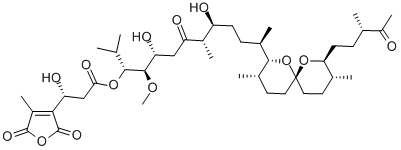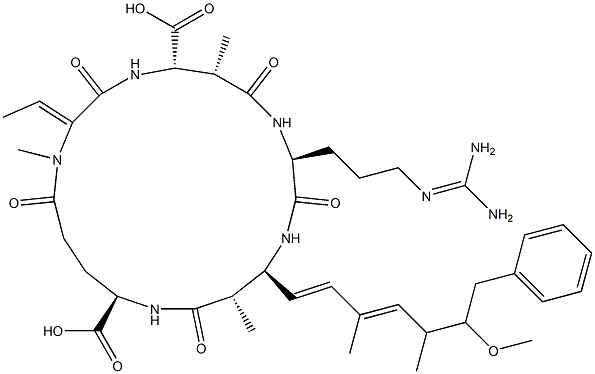CALYCULIN A
Synonym(s):Calyculin A, Discodermia calyx - CAS 101932-71-2 - Calbiochem;InSolution Calyculin A, Discodermia calyx - CAS 101932-71-2 - Calbiochem
- CAS NO.:101932-71-2
- Empirical Formula: C50H81N4O15P
- Molecular Weight: 1009.17
- MDL number: MFCD06795864
- SAFETY DATA SHEET (SDS)
- Update Date: 2024-11-13 18:13:23

What is CALYCULIN A?
The Uses of CALYCULIN A
Calyculin A is a PP1 and PP2A-C inhibitor and tumor inducer.
The Uses of CALYCULIN A
Inhibitor of phosphatases 1 and 2a.
The Uses of CALYCULIN A
Calyculin A from Discodermia calyx has been used:
- as an inhibitor of serine-threonine protein phosphatase 2A
- as an inhibitor of cyclin D1 phosphatase in human breast cancer cells
- as an inhibitor of protein phosphatase 2A (PP2A) and PP1 in mouse melanoma cell lines B16-F0 cells
What are the applications of Application
Calyculin A is a cell-permeable inhibitor of phosphatase 1 (PP1) and protein phosphatase 2A (PP2A-C), and may promote tumor growth
General Description
Calyculin A is derived from the marine sponge Discodermia calyx. It corresponds to a molecular weight of 1008 Da.
Biological Activity
Potent and selective cell-permeable inhibitor of protein phosphatase 1 (IC 50 = 0.3-0.7 nM) and protein phosphatase 2A (IC 50 = 0.5-1 nM). Displays > 10,000,000-fold selectivity over PP2B and PP2C.
Biochem/physiol Actions
Inhibitor of protein phosphatases types 1 and 2A; marine toxin, potent tumor promotor.
storage
Store at -20°C
Properties of CALYCULIN A
| Melting point: | 247-249° |
| alpha | D -60° (c = 0.1 in ethanol) |
| Density | 1.25±0.1 g/cm3(Predicted) |
| storage temp. | -20°C |
| solubility | DMSO: soluble |
| pka | 1.81±0.10(Predicted) |
| form | solid |
| color | white |
| Water Solubility | Soluble in DMSO (50 mM), ethanol (1 mg/ml), methanol, acetone, acetonitrile, chloroform, methylene chloride, and benzene. Insoluble in water. |
| Merck | 13,1731 |
| BRN | 4903216 |
Safety information for CALYCULIN A
| Signal word | Danger |
| Pictogram(s) |
 Skull and Crossbones Acute Toxicity GHS06 |
| GHS Hazard Statements |
H315:Skin corrosion/irritation |
| Precautionary Statement Codes |
P261:Avoid breathing dust/fume/gas/mist/vapours/spray. P264:Wash hands thoroughly after handling. P264:Wash skin thouroughly after handling. P280:Wear protective gloves/protective clothing/eye protection/face protection. P301+P310:IF SWALLOWED: Immediately call a POISON CENTER or doctor/physician. |
Computed Descriptors for CALYCULIN A
New Products
Tert-butyl bis(2-chloroethyl)carbamate 4-Methylphenylacetic acid N-Boc-D-alaninol N-BOC-D/L-ALANINOL 3-Morpholino-1-(4-nitrophenyl)-5,6-dihydropyridin- 2(1H)-one Furan-2,5-Dicarboxylic Acid Tropic acid 1,1’-CARBONYLDIIMIDAZOLE DIETHYL AMINOMALONATE HYDROCHLORIDE R-2-BENZYLOXY PROPIONIC ACID 1,1’-CARBONYLDI (1,2-4 TRIAZOLE) N-METHYL INDAZOLE-3-CARBOXYLIC ACID (2-Hydroxyphenyl)acetonitrile 4-Bromopyrazole 5-BROMO-2CYANO PYRIDINE 5,6-Dimethoxyindanone 5-broMo-2-chloro-N-cyclopentylpyriMidin-4-aMine 2-(Cyanocyclohexyl)acetic acid 4-methoxy-3,5-dinitropyridine 2-aminopropyl benzoate hydrochloride 1-(4-(aminomethyl)benzyl)urea hydrochloride diethyl 2-(2-((tertbutoxycarbonyl)amino) ethyl)malonate tert-butyl 4- (ureidomethyl)benzylcarbamate Ethyl-2-chloro((4-methoxyphenyl)hydrazono)acetateRelated products of tetrahydrofuran








You may like
-
 Calyculin A, from Discodermia calyx, ≥90% (HPLC) CAS 101932-71-2View Details
Calyculin A, from Discodermia calyx, ≥90% (HPLC) CAS 101932-71-2View Details
101932-71-2 -
 Calyculin A, Discodermia calyx CAS 101932-71-2View Details
Calyculin A, Discodermia calyx CAS 101932-71-2View Details
101932-71-2 -
 Calyculin A from Discodermia calyx CAS 101932-71-2View Details
Calyculin A from Discodermia calyx CAS 101932-71-2View Details
101932-71-2 -
 Calyculin A from Discodermia calyx CAS 101932-71-2View Details
Calyculin A from Discodermia calyx CAS 101932-71-2View Details
101932-71-2 -
 Calyculin A, Discodermia calyx CAS 101932-71-2View Details
Calyculin A, Discodermia calyx CAS 101932-71-2View Details
101932-71-2 -
 14714-50-2 (2-Hydroxyphenyl)acetonitrile 98+View Details
14714-50-2 (2-Hydroxyphenyl)acetonitrile 98+View Details
14714-50-2 -
 118753-70-1 98+View Details
118753-70-1 98+View Details
118753-70-1 -
 733039-20-8 5-broMo-2-chloro-N-cyclopentylpyriMidin-4-aMine 98+View Details
733039-20-8 5-broMo-2-chloro-N-cyclopentylpyriMidin-4-aMine 98+View Details
733039-20-8
Statement: All products displayed on this website are only used for non medical purposes such as industrial applications or scientific research, and cannot be used for clinical diagnosis or treatment of humans or animals. They are not medicinal or edible.